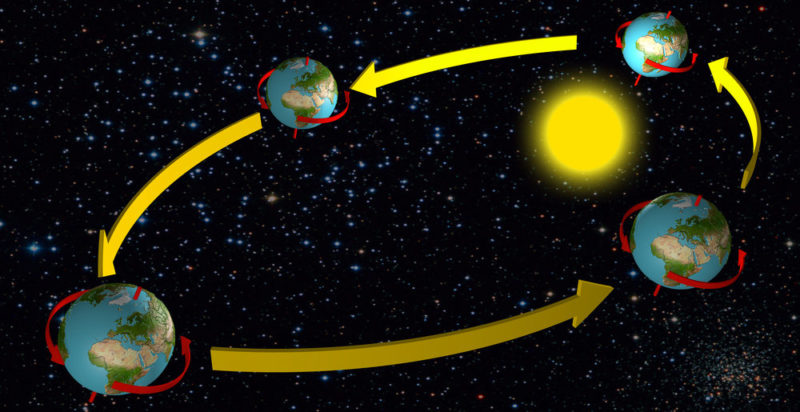We explain what the Earth's movement is and the consequences of this movement. The speed it reaches and the rotation of the Earth.

What is the Earth's movement?
The movement of the Earth is one of the movements that the planet makes and consists of going around the Sun. It takes 365 days and 6 hours to complete the journey. Every four years, those hours are added up to a total of 24 hours. That is the reason why, every four years, we have a leap year in our calendar, in which the month of February has one more day.
The translation movement It occurs in Earth's orbit and reaches a distance of 930 million kilometers. Although the average distance between the Earth and the Sun is 150 million kilometers, the ellipse or oval-shaped orbit means that, in some sections, the Earth is closer to the Sun and in others, further away. These distances cause climatic differences on the planet that give rise to the seasons of the year.
See also: Ozone layer
Consequences of translational movement

The two main consequences of the Earth's translational movement are:
- The succession of the seasons of the year The Sun's energy heats the planet's surface with different intensity, depending on the inclination of the Earth's axis. Therefore, during the translational movement, when the Earth is further away from the luminous star, the rays impact directly and with greater energy intensity. On the other hand, when the Earth is close to the Sun the rays are projected in a curve, which causes a loss in energy intensity. These variations produce different temperatures that give rise to the four seasons of the year:
- Spring The season begins with the spring equinox, between March 20 and 21 in the northern hemisphere, and between September 22 and 23 in the southern hemisphere.
- Summer It is the hottest season and begins with the summer solstice, on June 21 in the northern hemisphere and December 21 in the southern hemisphere.
- Autumn It begins in the Northern Hemisphere with the autumn equinox, around September 23 in the Northern Hemisphere and March 21 in the Southern Hemisphere.
- Winter It is the coldest season that begins with the winter solstice, between December 20 and 23 for the northern hemisphere, and between June 20 and 23 for the southern hemisphere.
In the regions of the equator, the climate is tropical throughout the year because the Sun's rays are projected directly, without too many alterations. There are only two seasons that differ in the intensity of rain: the dry season and the rainy season.
- The length of day and night Although the movement of the Earth's rotation produces day and night, it is the translational movement of the Earth that determines that the days are longer and the nights shorter or vice versa, depending on the season of the year (i.e. , the distance the planet is from the Sun).
Earth's translation speed
Because the Earth moves on its elliptical orbit, the speed of the translational movement is not constant, it has a slight variation. It is estimated that The approximate travel speed is 107,000 kilometers per hour. We do not feel it because of the force of Earth's gravity, which attracts everything on the Earth's surface like a magnet.
Earth rotation

The rotation movement occurs when a body, such as planet Earth, rotates on its own axis, which remains fixed. On the other hand, translational motion is the movement that a celestial body makes when rotating in its orbit around the Sun.
The Earth's axis is an imaginary line that is not straight but It has an inclination angle of 24° with respect to the Earth's orbit. This inclination causes the Sun's rays to impact with different intensity in the northern hemisphere compared to the southern hemisphere.
References
- «Earth Movements» in Online Meteorology.
- “Tropical Rain Belt” in Wikipedia.
- “Earth's movement” in Wikipedia.
- “The Translation of the Earth” in Astrojem.
- “Effects of the Sun on Earth” in Windows 2 Universe.





